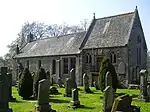Bowden, Scottish Borders
Bowden is a village in the Roxburghshire area of the Scottish Borders, situated 3 miles (5 kilometres) south of Melrose, 2 miles (3 kilometres) west of Newtown St Boswells and tucked in the shadow of the Eildon Hills, Scotland.
| Bowden | |
|---|---|
 Bowden Village Hall built 1896 | |
 Bowden Location within the Scottish Borders | |
| Population | 223 [1] |
| OS grid reference | NT555305 |
| Council area | |
| Lieutenancy area | |
| Country | Scotland |
| Sovereign state | United Kingdom |
| Post town | MELROSE |
| Postcode district | TD6 |
| Dialling code | 01896 |
| Police | Scotland |
| Fire | Scottish |
| Ambulance | Scottish |
| UK Parliament | |
| Scottish Parliament | |
History
In 1113, when King David I of Scotland granted lands to the monks of Selkirk, he also granted them the land at Bothandene (Bowden) and Hailiedene (Holydean). The charter was renewed in 1124 when the monks moved to Kelso, where they founded the magnificent Kelso Abbey. At the same time a religious establishment was founded at Bowden. The abbot of Kelso built a tower at Holydean which was destroyed in 1296. The tower was rebuilt and extended by Isabel Ker of Cessford and renamed Castle Holydean. The castle became the home of the Ker family, later the Dukes of Roxburghe, who lived there for two centuries before the castle was finally destroyed in 1760 by the 3rd Duke, John Ker. The Roxburghes moved to their new home, Floors Castle, in the early 18th century.
In 1531, Bowden village was granted the right to hold a market, the first non-burghal market in Scotland, and a market cross which still stands today was erected - such was the importance of the village in mediaeval times. The cross is now used as the parish war memorial.
The present Bowden Kirk was greatly enlarged in the 17th century, but parts of an older church are still evident. The church is unusual inasmuch as it has three bells, two of which are still in use. The third bell is contained inside the church and bears the inscription SOLI DEO GLORIA JOHN MEIKEL ME FECIT EDINBURGHII ANNO 1690, meaning "I was built by the grace of God at Edinburgh in 1690 by John Meikle". John Meikle was an eminent bell maker and tuner in 17th century Edinburgh. The old kirkyard contains many interesting gravestones and, under the east wing, a burial vault which contains 22 members of the Ker family, six of them Dukes of Roxburghe. The church is embellished with some wonderful stained glass windows including the Priest's Door, built at the old priest's doorway.
Bowden has been blessed with education since just after the Scottish Reformation in 1590. The last school was built in the middle of the 19th century but closed in the mid 20th century. The school and schoolmaster's house are still standing and are used as private homes.
The Bowden village well was erected in 1861 and still stands in the atmospheric village adjacent to the old school. The village hall was erected in 1896.
While the first mention of Bowden is in the early 12th century, its original name of Bothanden is from the old English language meaning houses at the stream, the stream in question being the Bowden Burn which cuts through the village. Many artifacts from the Iron-Age have been found in and around Bowden, and there were even traces of an old military road from the Romans in Scotland period. It is known that ancient British tribes lived on the Eildon Hills. The Romans built a fort at nearby Newstead and named it Trimontium, meaning three hills.
Originally the people of Bowden were farm labourers and weavers, but in modern times the village is inhabited by many professional people, including doctors, nurses and schoolteachers. After local government restructuring in the early 1970s, Bowden became part of the newly formed Scottish Borders Council.
The war memorial in Bowden dates from 1915, reflecting the early local sacrifice made by this community during World War One. The memorial was designed by Sir Robert Lorimer.[2]
Community Facilities
Bowden has a recently refurbished village hall in the centre of the village. This building has a hall with capacity for 100 people and several break out rooms. Catering facilities are also available. To the south of the village lies the village church, which dates back to 1128.
Notable people associated with Bowden
- Thomas Aird
- Lady Grisell Baillie
- Lauder Brunton
- William Dick (d. 1925), supported Bowden's village development with his legacy[3]
Listed Buildings
There are many listed buildings, of various categories, in around the village of Bowden, including the kirk, schoolhouse, market cross and the well.
 Mediaeval kirk (extended 17th century)
Mediaeval kirk (extended 17th century) Bowden Church bell (1690)
Bowden Church bell (1690) Market cross (1531)
Market cross (1531)
See also
References
- "Archived copy". Archived from the original on 8 November 2014. Retrieved 30 October 2014.CS1 maint: archived copy as title (link)
- Dictionary of Scottish Architects: Robert Lorimer
- "William Dick". Bowden Scotland. Retrieved 20 July 2015.
- Groome, Francis. The Ordnance Gazetteer for Scotland pages 181-182
- New Statistical Accounts for Scotland 1799 and 1834.
External links
| Wikimedia Commons has media related to Bowden, Scottish Borders. |